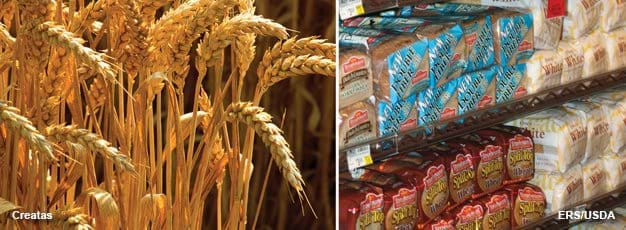Food Commodity Cost Pass-Through to Food Prices Not Uniform

Prices for wheat, corn, and other major field crops and for agricultural products like cattle and fluid milk have spiked several times during the past decade. How much of the increased food commodity input costs are passed through to retail food prices depends on a variety of factors, including the value added at each stage in the production process.
A recent analysis by ERS researchers found that wholesale prices of beef and wheat flour generally track changes in farm prices for cattle and wheat; that is, a significant portion of farm price changes typically shows up in wholesale wheat flour and beef prices. Retail beef and bread prices, in contrast, have a more complicated and, oftentimes, less direct response to wholesale price changes.
ERS researchers analyzed 1972-2008 price data for three stages of wheat and beef marketing--farm-level wheat and cattle, wholesale wheat flour and beef, and retail bread and beef--using a model that considered both the short- and long-term relationships between input and output prices. The researchers were especially interested in investigating differences in price response when farm prices were gradually changing versus times of more dramatic shifts.
A number of differences in response behavior were found both between the two food items and among the different marketing stages. During 2000-2008, wholesale beef prices reflected an average of 53 percent of a typical change in cattle prices, while wholesale prices of wheat flour reflected, on average, 30 percent of the change in farm-level wheat prices.
The cost pass-through from wholesale to retail was generally weaker than from farm to wholesale. Retail beef prices incorporated 19 to 29 percent of a typical change in wholesale beef prices, on average, from 2000 to 2008, while retail bread prices incorporated 16 to 21 percent of the change in wholesale wheat flour prices. The smaller pass-through rates for wheat flour and bread reflect the additional inputs used to produce a more processed item (a loaf of bread versus cuts of beef).
The timing of the cost pass-through also varied at different marketing stages. For both beef and wheat flour, most of the change in response to farm prices was passed on to wholesale prices within the first month. In contrast, the speed of response for retail beef and bread prices depended upon the direction and size of wholesale price movements. When wholesale beef prices declined, retail prices generally exhibited most of the pass-through of wholesale price changes within 2 months. When wholesale wheat flour prices were decreasing or modestly increasing, retail bread prices showed most of their response after 2 to 4 months. However, when wholesale prices surged upward, retail beef and bread prices both showed the bulk of their response within the first month.
How Retail Beef and Bread Prices Respond to Changes in Ingredient and Input Costs, by Edward Roeger and Ephraim Leibtag, USDA, Economic Research Service, February 2011
Food Markets & Prices, by Hayden Stewart and Eliana Zeballos , USDA, Economic Research Service, March 2023

